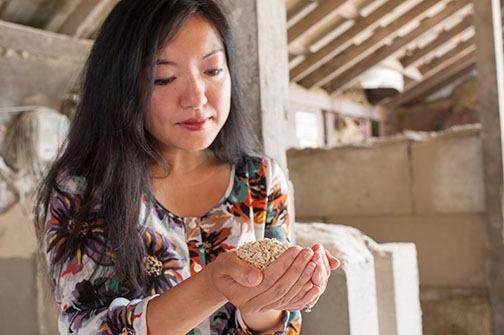Reviewed by Alex SmithMay 5 2022
Researchers at Michigan State University are predicting the impact of climate change on crops such as maize as weather patterns throughout the world, especially the Midwest, continue to shift.
 Felicia Wu. Image Credit: Michigan State University.
Felicia Wu. Image Credit: Michigan State University.
The United States is the largest exporter and donor of field corn around the world. Here in the U.S., we consume field corn in the form of corn chips, corn flakes, corn grits and corn tortillas; as opposed to sweet corn, which is frozen, canned and eaten off the cob. Field corn is also used for animal feed and for ethanol production.
Felicia Wu, Professor, Department of Agricultural, Food, and Resource Economics, College of Agriculture and Natural Resources, MSU
Aflatoxin is produced by the fungus Aspergillus flavus and Aspergillus parasiticus, which can infect peanuts, tree nuts and maize. Aflatoxin decreases maize quality, and depending on the amount and length of time it is consumed, it might cause health concerns for people and animals. Aflatoxin contamination occurs regularly in the southern United States due to the hot and dry environment, it has rarely been a severe issue in the Corn Belt.
Wu added, “When we ran our near-term climate model scenarios, we found that between 2031-2040, aflatoxin is going to become more of a problem in the U.S. Corn Belt in the Midwest. The last time there was a serious problem was in 2012 when we had an unusually hot and dry summer throughout the Midwest; particularly Iowa, Illinois and Indiana.”
Wu’s research was published in the journal Environmental Research Letters on April 5th, 2022. Jina Yu from Hong Kong Baptist University, David Hennessy from Iowa State University, and Jesse Tack from Kansas State University are co-authors of the work.
Fungi spores are more likely to become airborne under hot and dry circumstances, increasing their chances of infecting crops. Water enhances plant resistance to stress, which renders them susceptible to pathogenic fungus.
Growers, grain elevators and processors can limit the danger of aflatoxin contamination by storing corn harvests in cold, dry conditions and irrigating fields as much as feasible, despite lowering water tables.
Researchers are already developing hybrid crops that can tolerate drought, insect damage and fungal diseases using both biotechnological and traditional breeding approaches. Corn producers in various parts of the world are employing biocontrol to minimize aflatoxin levels.
Since these fungi compete with aflatoxin-producing fungus, biocontrol infects plants with Aspergillus fungi that are unable to make aflatoxin.
Another option is to move crop production north or south, where the environment is milder or wetter, to lower aflatoxin risk. However, this has an impact on farms that have been passed down through the centuries.
Wu advises individuals concerned about aflatoxin exposure from eating field corn to eat their greens and garlic.
Wu explained, “Green leafy vegetables are good for your overall health. Chlorophyll has a sandwich molecular structure that traps aflatoxin molecules so that humans excrete them before the toxin can enter our bloodstream.”
Additionally, leafy vegetables such as broccoli, cauliflower and kale, as well as allium vegetables such as garlic, onions, and leeks, can assist in the detoxification of carcinogens in our systems.
“We predict seeing an increase in aflatoxin problems over the next 10-20 years. So, we need to rely on technologies and a whole suite of interventions that can reduce the problem,” Wu stated.
Journal Reference:
Yu, J., et al. Climate change will increase aflatoxin presence in US Corn. Environmental Research Letters. doi.org/10.1088/1748-9326/ac6435.